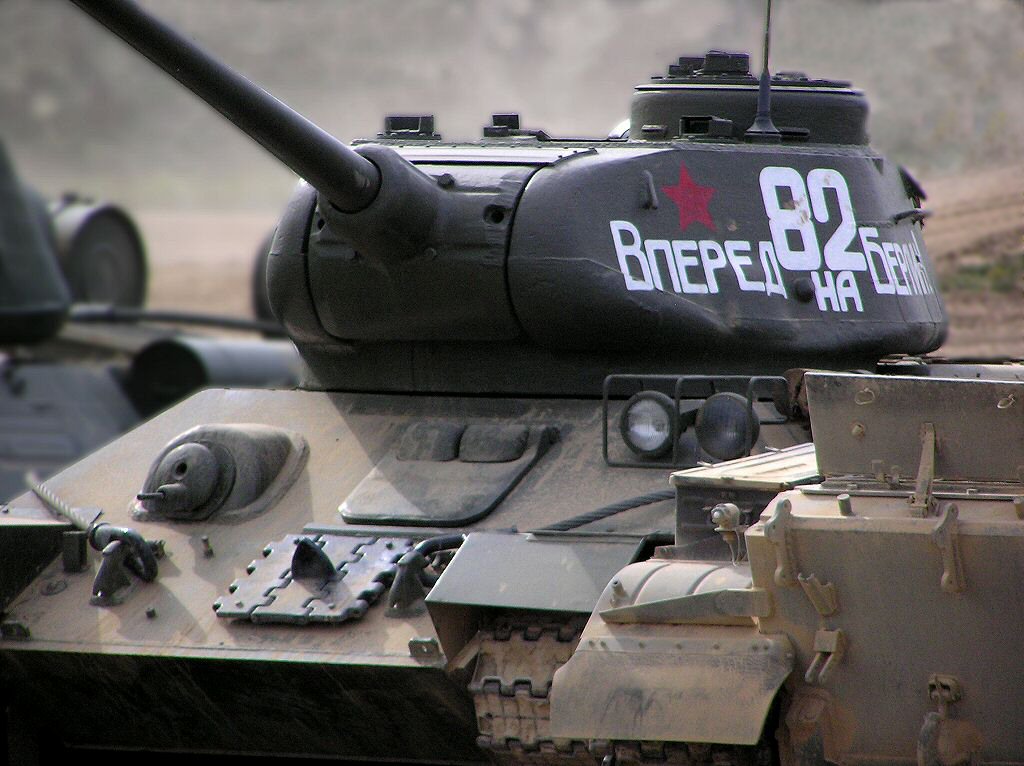|
|
|
How to download
the photographic computer wallpaper |
Russian Soviet T34/76 Medium Tank of World War Two's Eastern FrontThe Russian T34 tank was fitted with two different guns. The size of the gun lead to the model identification. In 1940 the T34/76 was fitted with a 76.2mm F-34 L/41.5 gun and two 7.62mm DT machine guns. It had 70mm frontal armour. Max speed of 55-60 km/h. A road range of 460km. A crew of 4 men and it weighed 30900kg. In 1944 the T34/85 was fitted with a 85mm Zis-S-53 gun and two 7.62mm DT machine guns. It had 45-90 mm frontal armour. Max speed of 55 km/h. A road range of 350km. A crew of 4 men and it weighed 32000kg. When the German Army first encountered the T34 Medium Tridsatchedverka Tank in late 1940 on the Eastern Front they received a nasty shock. This was in the days before the Panther V panzerkampfwagen tank. It was the most advanced tank design in the world at that time. Its revolutionary sloped armour design deflected incoming shells and increased it’s battlefield survivability. It also featured, speed, hitting power and low silhouette along with reliability and low production cost. T-34/76 was produced in six main variants, the model T34/76 A was produced in 1940, the model T34/76 B was produced in 1941, the model T34/76 C was produced in 1942, the model T34/76 D was produced in 1943, the model T34/76 E was produced in 1943 and the model T34/76 F was produced in 1943. 35119 T-34/76 tanks were produced between 1940 to 1944. The German Army’s response was to incorporate many features of the Soviet T-34/76 Tank in their superb new tank Panzerkampfwagen V Panther tank. The Germans captured a large number of T-34/76 tanks and reused them with german crews, because until the Panther V tank arrived they did not have anything to match them. They called these captured Tanks pressed into service with the German Army Panzerkampfwagen T-34 747(r). Not so many T-34/85 tanks were used by the Germans as the Panther and Tigers were then available. To stop friendly fire situations, crews painted large-dimension crosses or even swastikas on the captured tanks. It was very common for crews to paint a cross or swastika on top of the turret in order to prevent the planes of the Luftwaffe from attacking them. Italian crews even operated a few captured T-34/76 tanks in the summer of 1943 Badly damaged T34 tanks were used as as pillboxes. Some T34 turrets were mounted on railway wagons. These trains came in different styles i.e Panzerjaegerwagen - tank destroyer wagon, Panzerzug - armored train, Streckenschutzug - railway protection train and Panzertriebwagen - armored locomotive. An interesting conversions based on T-34/76 (model 1943) chassis was 2cm Flakvierling auf Fahrgestell T-34(r), an anti-aircraft tank - Flakpanzer. It was also known as Flakpanzer T-34(r), armed with four 20mm Flakvierling 38. By the end of the war some 29430 of the new and improved T34/85 tanks were produced. It was armed with 85mm gun. Electric turret traverse was added and with the new gun that was equal to the infamous German 88mm, the T34/85 tank achieved a tremendous increase in fast accurate firepower with little additional weight. A third crewman was added to the complement in the bigger turret to handle loading of the gun bringing the crew up to five. Only a few T34/85 tanks were captured and even fewer were pressed into service by the German Army The T34/85 was the core of the North Korean and Chinese armoured units During the Korean War North Korea's world war 2 Russian made T-34/85s completely overwhelmed the American light M24 Chaffee tanks employed against them by the Allies. It’s excellent cross-country mobility and the tank's 85 mm gun still packed a considerable punch. America hurriedly shipped in M26 Pershing Tanks to meet the threat and by September 1950, Allied tanks outnumbered North Korea's by at least five to one. . In 1996, many nations including: Afghanistan, Albania (approx. 70), Angola (approx. 58), Guinea Bissau (approx. 10), Cuba (approx. 400), Mali (approx. 18), Romania (approx. 1000), Slovenia, Hungary (approx. 5), Vietnam, Bosnia and other nations still had in service T-34/85 Tanks. Model Armored Tanks, Assault Guns, Tank Destroyers & AFVThere are many companies that now make model kits of Armored Tanks, Assault Guns, Tank Destroyers, AFV & Military Vehicles in various scales. Here are a few of them. Fujimi 1/76 plastic kit, Hinchliffe Skytrex in 1/76 scale, RAFM, AIRFIX model, Revell, MILICAST, Bandai, Academy model kits, Boford models, combat group dynamix, corgi, doyusha, 1/35 scale, 1/144 micro scale, 1/72 scale, Minichamps military diecast vehicles, Marui shooting tanks, Popy, modles, Revel, Solido, Takara, Tamiay, Tamiya, F-toys, Forces of Valour, Trumpeter, Franklin mint, Wartanks, resin, diecast, Furuta, Gaincorps, Dioramas, verlinden decals, Dragon, armour, ICM models, Italeri, Haasegwa, Testor, AFV club Russian Soviet Army Tanks of World War Two & OneSoviet T-26, T-27, BT-7, BT-5, Soviet T-34, T34/76 medium Russian soviet army Tank, T-60, T-70, IS-1/2 heavy Russian soviet army Tank, T-54/55 medium Russian soviet army Tank backbone of the tank weapon of the Warshaw Pact, T-10 heavy Russian soviet army Tank , T-62 medium Russian soviet army Tank Eastern Block's main tank, T-72 heavy Russian soviet army Tank, T-80 heavy Russian soviet army Tank, KV-1 heavy Russian soviet army Tank, Warshaw Pact. Iosef Stalin or joseph stalin , KV-1 Red Army’s standard heavy tank until 1943, KV-2 was made to support infantry, KV 3 Tank, Tankograd, T80, T84 T-90 and T94
|
www.MooreWallpaper.com Add our site to your 'Favorites' list now!
![]()
![]() (Website
design by Craig
Moore, London, England)
(Website
design by Craig
Moore, London, England)
